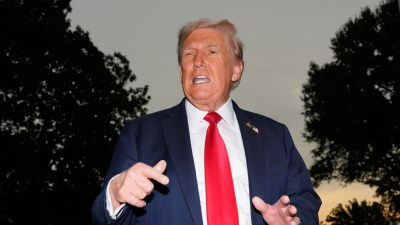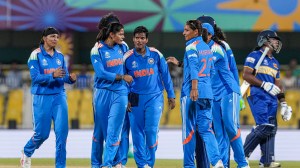Allrounders from states
Who’s who of our politicians who dominate the cricket boards in their respective home states

BIHAR
Father, mother and sons
Cricket threw up a lot of off-field drama here in the last five years. It all started with the bifurcation of Bihar in 2000. It was then that Laloo set his eye on the president’s post of the Bihar Cricket Association (BCA). His opponents saw it as yet another shrewd ploy to promote his two sons who were aspiring to make it big in the cricketing arena.
It did not take Chief Minister Rabri Devi long to bestow the highest sporting award of the state on her son Tejaswaee Prasad. She herself handed over the honour at a function in Patna.
In 2001, Laloo was elected the BCA chief and under his leadership the BCA went to demand BCCI recognition, claiming it was the original body.
In subsequent elections for the BCCI chief’s post, Laloo Yadav openly sided with AC Muttiah against Jagmohan Dalmia. After Laloo’s candidate lost, his aspiration to get the BCA recognised by BCCI remained unfulfilled.
Then BJP MP and former cricketer Kirti Azad floated a parallel body — Association of Bihar Cricket (ABC) — along with Saba Karim, claiming that his was the only body devoted to promote cricket in the state. Open political battle over cricket continued between the two rival camps and the matter even reached the Patna High Court. Meanwhile, the BCCI refused recognition to both BCA and ABC.
Recently, the NDA government led by Nitish Kumar planned an ordinance to oust Laloo Yadav from the BCA post. It is learnt that the ordinance was turned down by acting Governor Gopal Krishna Gandhi.
— J P Yadav
Punjab and Haryana
Higher-level politics
If not in the state association itself, the Punjab and Haryana cricket associations have been covertly involved in the tussle for power in the BCCI. Haryana politician Ranbir Singh Mahendra, who was ousted from the post of board president by some intense lobbying and calculated moves of the Punjab Cricket Association (PCA) head Inderjit Singh Bindra and Rajasthan Cricket Association (RCA) supremo Lalit Modi, still enjoys unstinted support from his supporters in the Haryana Cricket Association (HCA). A staunch Jagmohan Dalmiya ally, HCA secretary Mahendra lost the BCCI presidentship to Union Agriculture Minister Sharad Pawar in November last year.
Even PCA being manned by Bindra as president and M P Pandove as the secretary general for the past 25 years has never been the bone of contention for Punjab politicians. Rather top Punjab politicians have always preferred the backseat in the PCA. Even when Bindra was pushed to the corner by Dalmiya and Co no move was initiated by any of the top BCCI office-bearers to install someone as the PCA chief.
—Ikhhlaq Singh Aujla
HIMACHAL PRADESH
CM vs CM
If former chief minister Prem Kumar Dhumal used his position to get son Anurag Thakur, a Ranji player, the presidentship of the Himachal Pradesh Cricket Association, the Virbhadra Singh government used the legislature to dump him. In came Rajinder Zar, former BCCI vice-president and state Congress vice-president. Zar is recognised as president by the BCCI but Thakur is fighting a battle in both the High Court and Supreme Court.
When the BJP’s Dhumal came to power, he got Praveen Sharma, state excise and taxation minister, to handle Thakur’s ascension. ‘‘As father and chief minister, Dhumal was firm on the agenda for Anurag,’’ recalls an HPCA functionary. Thakur proved capable, if biased towards the BJP. The Dharamshala cricket stadium, constructed at an investment of Rs 12 crore, is surely his greatest contribution to Himachal cricket.
Then, in April 2005, the new Congress government under Virbhadra Singh passed the Himachal Pradesh Sports (Registration, Recognition and Regulation of Associations) Act, 2005, making it mandatory for all 43 sports bodies to get affiliated to the state government-manned HP Sports Council. The Act also included provisions for appointment of observers for the elections to the sports’ bodies. Thakur’s faction opposed the government move and challenged the Act in the high court. By then the faction led by Zar, known for his proximity to former Union minister Sukh Ram, had gathered the political clout to oust Thakur as HPCA president. Thakur’s case is listed for final hearing in the high court on June 28.
—Ashwani Sharma
RAJASTHAN
Running with the govt
As former chief minister Ashok Gehlot would have it, ‘‘The Rajasthan government is Modi’s B-Team.’’ BCCI vice-president cum marketing maestro Lalit Kumar Modi’s closeness to Chief Minister Vasundhara Raje is well-known. Within a year of winning the election, the Raje Government slogged hard with single-minded devotion to take over control of sports associations in the state, ostensibly to make sports administration more transparent. But insiders knew the real agenda: fix the match for Modi. In 2004, the government issued an ordinance (which later became law) giving voting rights to district-level committees of various sports bodies. Simultaneously, it abolished the voting rights of the ‘permanent members’ in these associations. Then it scrapped the Rajasthan Cricket Association run by the Rungtas since the 70s, and replaced it with an ad-hoc committee comprising government officials. When elections for the RCA were announced in February 2005, the pitch was ready for Modi to swagger in in his designer suits and start pinch hitting. While representatives of district associations (under government influence) voted en masse for Modi, the votes of the permanent members (all Rungta loyalists) were not counted. The result: RCA completely Modi-fied.
To his credit, Modi has ensured that Jaipur became a permanent fixture on the cricket map, there is talk of better infrastructure and a new stadium. But his run-in with the authorities in Abu Dhabi reportedly poisoned the relations with the cricket administrators in the Gulf. His brashness and his continued interference in the bureaucracy have caused heartburn. Surrounded by powerful enemies like the Rungtas and Morarkas, Modi seems just a wrong shot away from dismissal.
—Sandipan Sharma
ASSAM
Association of politicians
The Assam Cricket Association (ACA) has been the preserve of politicians. Today it is headed by Gautam Roy, four-term Congress MLA, who himself succeeded former chief minister and AGP leader Prafulla Kumar Mahanta in 2002. Roy, however, is not the only politician in the ACA. Two of the five vice-presidents are not only politicians, but powerful ministers of the state: Health Minister Himanta Biswa Sharma and Tourism and Forest Minister Rockybul Hussain. Chief Minister Tarun Gogoi on the other hand is a patron of the ACA. But a slot above him is Union minister and another senior Congress leader Santosh Mohan Dev, who is a patron-in-chief.
Roy says his biggest achievement has been to provide cricket kit to all the district associations. ‘‘Such support to districts were never given before,’’ he says. He can take credit for producing Abu Nassim Ahmed, an Assam player who not only found a place in the Under-19 Indian squad, but also emerged as one of India’s leading wicket-takers in the Junior World Cup held in Sri Lanka earlier this year. Pervez Aziz has also found a place in the India Under-19. Roy also takes credit for the under-construction stadium at Guwahati.
—Samudra Gupta Kashyap
Gujarat
Long innings
Gujarat Cricket Association (GCA) president Narhari Amin is a consummate political creature. A top-ranking Congress member, he held several ministerial posts in the Chimanbhai Patel government in the 1990s. He was the sports and cultural minister when he won the GCA presidential election in 1992-93, ending Mrugesh Jaikrishna’s decade-old rule. His political connections and the fact that he once was the education minister of the state helped Amin to corner a sizeable chunk of the votes as many school and college owners have voting rights in the GCA election.
Cricket in Gujarat under Amin has grown manifold. Infrastructure and player facilities are of international standard. ‘‘By next year, the Sardar Patel Motera stadium will become the best in India with seating for 60,000,’’ says Amin, who is also involved in real-estate business. ‘‘When I took over, GCA had a liability of Rs 12 crore. I spent Rs 25 crore in the following 10 years to develop the stadium,’’ adds Amin. Interestingly, Jaikrishna built the Motera stadium by mortgaging his own house. However, it took Amin almost a decade to produce a national-level player in the form of Parthiv Patel.
—Swarup Kar Purkayastha
UTTAR PRADESH
Turf war
AT a time when UP has been able to prove its worth with four players—M Kaif, Suresh Raina, Rudra Pratap and Piyush Chawla—playing for India, the Uttar Pradesh Cricket Association (UPCA) is witnessing one of its darkest phases with the government of Mulayam Singh Yadav engaged in duel with the cricket body. It even led to Kanpur crying off as host of the third India vs Sri Lanka Test in December.
The government’s Sports Act was enacted to take over management of the state’s sports bodies. While the UPCA managed to escape the dragnet of the Actt by making itself a limited company, it has to pay the price whenever it requires a stadium to host a match. The ‘anointment’ of Congress MP Rajiv Shukla as the secretary UPCA was done in December 2005 to counter the Samajwadi Party’s Amar Singh, who wanted to take control of the UPCA, according to sources. Congress MP Shukla’s election as secretary, say UPCA officials, has gone a long way in helping UPCA get BBCI’s recognition at a time when the parallel UPCA under Amar Singh was making all out efforts to get itself stamped as the real state association.
—Wajiha Shah
Power play
The Mumbai Cricket Association, whose current president NCP leader Sharad Pawar fought a bitter battle to become BCCI chief last year, has had a long innings with political heads. From NKP Salve to Manohar Joshi to Pawar, power changes hands almost in consonance with the ruling dispensaiton in Maharashtra. As the cradle of talent and for long the standard bearer of modern Indian cricket, the MCA has benefited from its union with politics. Its presidents have often become BCCI chiefs too. Pawar fought a pitched battle in 2004 to dislodge Jagmohan Dalmiya from the BCCI but could not get the better of his proxy Ranbir Singh Mahendra until November last year, when with the courts in action and a whole lot of melodrama in Kolkata, he finally beat Mahendra to send Dalmiya on an ignominious way out. There are many who point out that Pawar has interfered with the selection process, getting Sourav Ganguly sidelined. But to his credit Pawar, as MCA president, has left cricket matters to a panel of experts while he concentrates on administration.
-Joel Rai



- 01
- 02
- 03
- 04
- 05



























